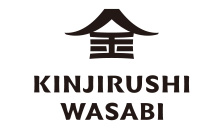When you click Q (question), A (answer) comes out.
 FAQ About Wasabi
FAQ About Wasabi
-
Q. Is the raw wasabi grated from the top? From the bottom?
-
A.
It is said that raw wasabi is better grated from the top with petiole (stem). The grated part of wasabi is called rhizome (tuber), and because it is a botanical stem, the upper part is the newer system. Therefore, because the color is bright and the fragrance is strong, it is said that it is better to grate from above. Leave a little stem and cut it off, grate it from above, if it remains, wrap it in a kitchen paper moistened with water, it can be stored for 1 to 2 weeks if you put it in a plastic bag and store it in a refrigerator. Also, it will last longer if you frequently replace the kitchen paper.
-
-
Q. Do I have to peel the raw wasabi skin?
-
A.
Since it is said that the part of the skin of the raw wasabi is spicy, it is better to wash the surface with a scrubbing brush and not peel the skin. There is bitterness in the skin, and the color gets a little dark when you grate, so you can lightly peel the skin as you like.
-
-
Q. What is made of shark skin grater?
-
A.
A shark skin grater is made of shark skin such as Squatina japonica or Squatina nebulosa. The skin is tanned and stuck on a wooden board. It is the best grater for a finely grated wasabi. You can get in hardware store or by online shopping services.
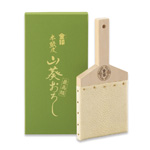
(Product Guide)
-
-
Q. What sort of wasabi is our wasabi?
-
A.
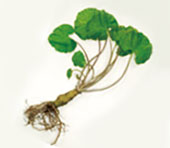
Common name Wasabi Scientific name Wasabia Japonica English name Wasabi Popular name Water grown wasabi, field wasabi Plant Perennial plant of Brassicaceae Place of origin Japan Wasabi is a plant originated in Japan, growing in mountain stream from the ancient times.
According to the cultivation method, this wasabi is divided into "water grown wasabi" and "field wasabi". Water grown wasabi is cultivated in 'wasabi-field' artificially made by using spring water and mountain stream. On the other hand, field wasabi is cultivated in cool and humid fields.
It varies depending on breed or cultivation, but it generally takes 1 year to 2 years from seedlings to become a fine horseradish. The major production areas in Japan are Shizuoka prefecture, Nagano prefecture, Iwate prefecture, Shimane prefecture, etc. Wasabi is usually grated from parts of roots commonly called tuber, and used for buckwheat, sashimi, sushi, noodles, etc. The grated one is green, somewhat sticky and fresh. It has a particularly refreshing fragrance and pungency.
-
-
Q. What sort of wasabi is horseradish?
-
A.

Common name Horseradish Scientific name Armoracia rusticana English name Horseradish Popular name Wasabi radish, mountain wasabi Plant Perennial plant of Brassicaceae Place of origin Europe The origin of horseradish is said to be from eastern Europe with moderate climate, and from Finland to the Caspian Sea. It is cultivated in places like Hokkaido in Japan. It was said that it came from western countries in Meiji period. It is called horseradish and it is the same Brassicaceae plant as the wasabi. However, the roots are large and it is as long as 30 centimeters. It has grated white roots, a slight stickiness, and a sharp pungency.
In Western food, grated items are also referred to as raifort and used for garnishing roast beef and so on. In Japan, after drying, it is used as the main ingredient of kona wasabi in powder form.Moreover, in Hokkaido, it is called "mountain wasabi", and it is familiar as home taste such as grilling it and putting it on warm rice and eating it as "wasabi meshi".
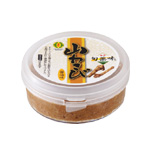
(Product Guide)
We have grated "Horseradish" from Hokkaido and seasoned it with soy sauce.
KINJIRUSHI online shop “Mountain wasabi seasoned condiment”
-
-
Q. What is the difference between wasabi and horseradish fragrance?
-
A.
For both wasabi and horseradish, the main ingredient of pungency is "allylmustard oil (allyl isothiocyanate)", but the fragrance varies greatly. There is sweet characteristic fragrance with freshness and green feeling in wasabi.
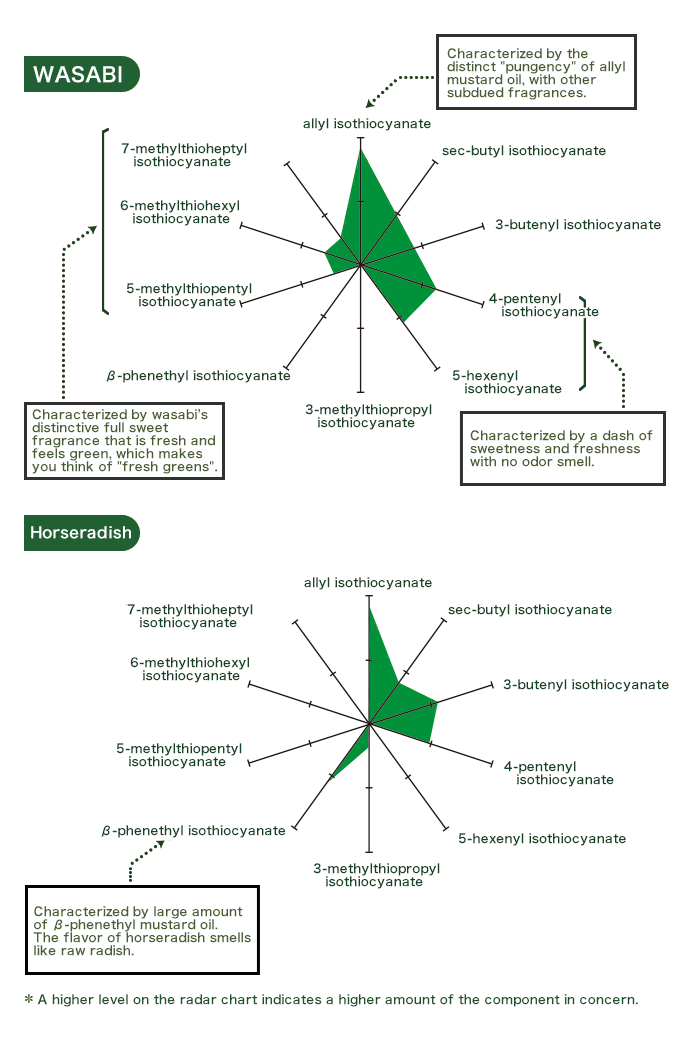
-
-
Q. How do you cultivate this wasabi?
-
A.
There are two methods to grow wasabi – hydroponic cultivation and field cultivation. With hydroponic cultivation, wasabi grows mountainous areas where spring water or clean streams flow. With field cultivation, wasabi grows in cool and humid fields.
Hydroponic cultivation
Hydroponic cultivation wasabi grows at a temperature of 8°C to 18.6°C and the optimum temperature is 12°C to 13°C. It is desirable to be below 16°C even during the summer, so you can cultivate it only in limited places in Japan, as it requires a clear and abundant amount of water.
The cultivation is divided into the following types.Tatamiishi-shiki Keiryu-shiki Jizawa-shiki Heichi-shiki Major
growing areasIzu Amagi district Chugoku mountain region such as Shimane, Tottori Tama - Abe River Upstream Region Hotaka-Azumino region Cultivation period 1.5 - 2 years 2.5 - 3 years 1.5 - 2 years 1 - 2 years Particularity - Abundant amount of water required
- Make step by step a sloping land, cultivate
- Method to hold sand on a natural stream and hold down the seedlings with a large stone
- Method to improve the Keiryu-shiki and cultivate a wasabi field like the Tatamiishi-shiki
- Effective utilization of less spring water is possible
- Use of underflow water
- Dig down a flat area (1 to 2m)
- Make a ridge and plant
Cultivation landscape 
Example: Shizuoka, Nakaizu

Example: Shimane, Hikimi

Example: Shizuoka, Abekawa

Example: Nagano, Hotaka
Source "Processed Wasabi - Knowledge and Q & A -" Japan Processing Wasabi Association
 Example: Shitara in Aichi prefecture
Example: Shitara in Aichi prefectureField cultivation
Wasabi in field cultivation is cultivated in a mountainous field, not where water flows. Wasabi cultivated in the forest is called forest wasabi. Cultivation is possible if conditions such as good drainage, cool summer, warm winter, etc. are met. Compare to hydroponic culture, it is easier to make a wasabi field.
-
-
Q. Why is wasabi spicy?
-
A.
For both wasabi and horseradish, the main ingredient of pungency is "allylmustard oil (allyl isothiocyanate)". You don't feel any pungency even if you bite a picked wasabi. It is possible to get strong pungency with a detailed grating. By grating, this will break the cellular tissue of the wasabi, the enzyme called myrosinase works, the mustard oil glycoside (sinigrin) is hydrolyzed, and its unique pungency (allylmustard oil) and fragrance are born. Also, since allylmustard oil is volatile, at the moment of eating, it escapes to the nose and stimulates the taste and olfactory cells.
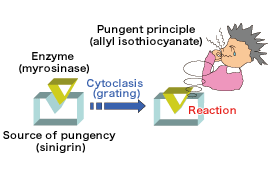
-
-
Q. Is there really an antimicrobial activity in wasabi?
-
A.
Antibacterial potency of wasabi's pungency ingredients has the function of suppressing the growth of many food poisoning bacteria such as Escherichia coli, Salmonella, Vibrio parahaemolyticus, Staphylococcus aureus. It also has the effect of suppressing the growth of mold and yeast.
Antibacterial and anti fungal data of wasabi
Growth of microorganisms in the presence of essential oil of 10 mg of plants
Sample name Bacillus subtilis
B.SubEscherichia coli
E.coliBaker's yeast
Sac.Black Aspergillus
Asp.Allylmustard oil - - - - Bois de rose oil + + + - Coriander oil - + + ± Citronella oil + + - - Eucalyptus oil ± ± - - Ho leaf oil ± + ± - Lemon grass oil - + - - Olibanum oil - + + - -: No growth allowed, +: Growth, ±: Neither.
(Ministry of Agriculture, Forestry and Fisheries, Food Research Institute)
<Data Description>
Using essential oil (fragrance ingredient) of various plants including allylmustard oil and other oils, which is a harsh ingredient of wasabi, as a result of experiments with a closed petri dish, it was confirmed that allylmustard oil had the effect of suppressing growth most for all four types of microorganisms such as Bacillus subtilis, Escherichia coli, baker's yeast, and Black Aspergillus mold.
In addition, when tested with allyl isothiocyanate (AIT), the main component of mustard oils, the growth of all the used bacteria was suppressed by adding a small amount of 31 to 420 micrograms (μg) per petri dish.
*1 (μg) is 1 part per million.Effect on parasites
Movement change of parasite (Anisakis)
Wasabi Paste Powdered Wasabi Wasabi 0.5g 2.0g 0.5g 2.0g 0.5g 2.0g 5 minutes Average Average Strong Weak Average Average 15 minutes Weak Weak Average Paralysis Strong Weak 30 minutes Weak Paralysis Weak Paralysis Weak Paralysis 60 minutes Immobility Immobility Immobility Immobility Weak Immobility Strong · · actively lively, Average · · involving only the body, Weak · · weakly involving the body,
Paralysis · · It does not move to stimulation, it starts to move after 24 hours, Immobility · · It does not move even after 24 hours.
(Tokyo Metropolitan Institute of Public Health, Mr. Iwao Murata, 1988)<Data Description>
We measured 0.5 g and 2.0 g of each of the three kinds of wasabi respectively, dispersed them in 0.4% salt water, as a result of observing how much time the activity dulls when putting parasite Anisakis in the salt water, although there are some differences in "paste", "powder" and "wasabi", all Anisakis became in a state in which it cannot work in 15 minutes (movement got dull). In other words, this is also due to the effect of allylmustard oil, the pungency ingredient of wasabi.
-
-
Q. What are the types of the processed wasabi?
-
A.
Processed wasabi is roughly divided into powder (powdered wasabi) and paste (wasabi paste, grated wasabi).
Powdered Wasabi
It is a product mainly based on dried and powdered horseradish, adding water and kneading it. They are canned and bagged.
Wasabi paste
This is a dried and powdered wasabi, a product that has been adjusted and processed by adding water to horseradish. They are tubed and pouched.
Grated Wasabi
It is a product using a raw wasabi and horseradish. They are tubed and pouched.
The ratio of wasabi to horseradish varies according to the product.
-
-
Q. What is the difference between the wasabi "used" and "added"?
-
A.
At the Japan Processing Wasabi Association, the following unified standards are set when displaying "wasabi used" and "wasabi added". If the amount of the wasabi is 50% or more, it is assumed that wasabi is used, and a sentence "Wasabi blended (or mixed) with horseradish" is displayed in close proximity. If the amount of the wasabi is less than 50%, it is assumed that wasabi is added, and a sentence "Horseradish blended (or mixed) with wasabi" is displayed in close proximity.
-
-
Q. About the expiration date of a wasabi small pouch attached to sashimi?
-
A.
Because it is a small pack with an internal volume of around 2g and the display space is small, display of the expiration date is not mandatory. If no expiration date is indicated, please do not store it, and use it with the items you purchased.
-

